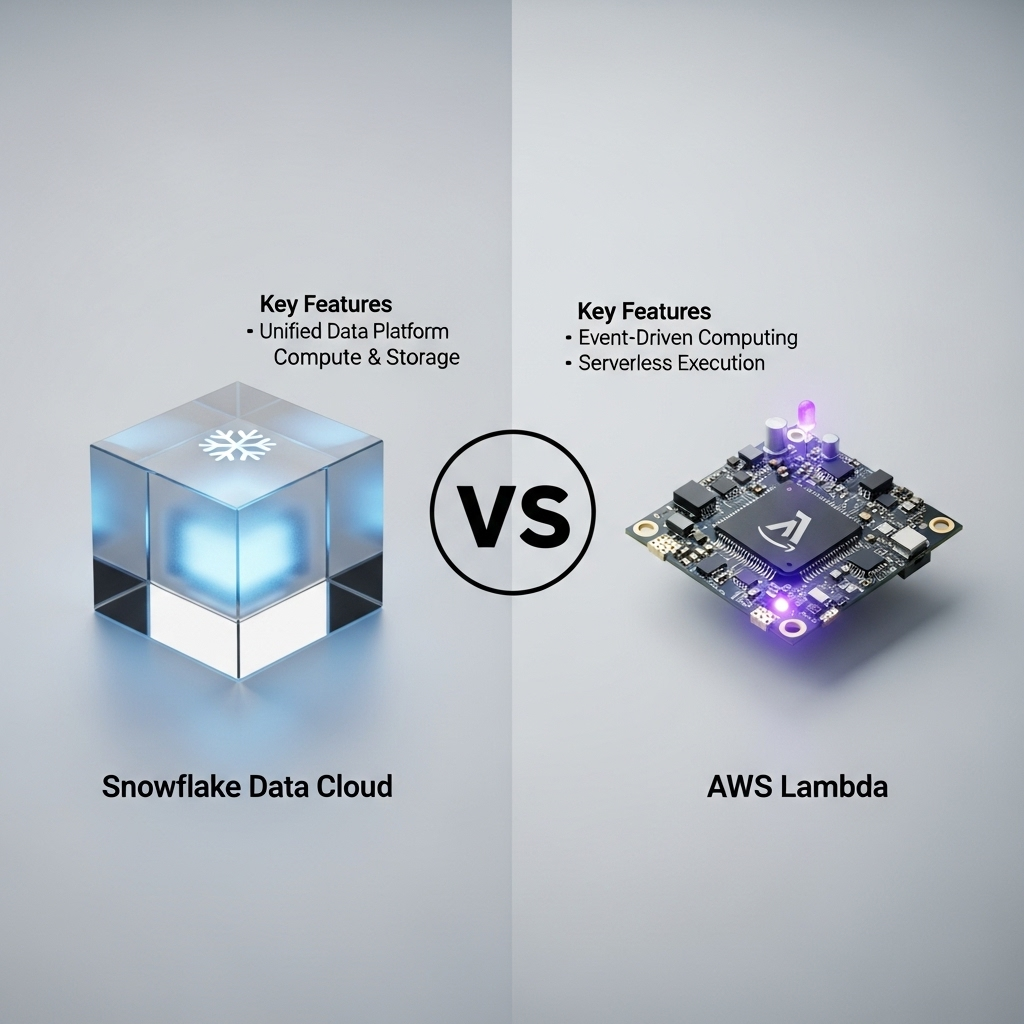Cloud services: Snowflake Data Cloud vs. AWS Lambda
Quick Verdict
Snowflake is better suited for large-scale data warehousing and analytics, while AWS Lambda is better for serverless computing and event-driven applications.
- Snowflake excels in data warehousing and analytics with strong SQL support and scalability.
- AWS Lambda is ideal for event-driven computing and serverless applications with pay-per-use pricing.
- Both offer robust security and compliance features.
- Both platforms offer real-time data processing capabilities.

Key features – Side-by-Side
| Attribute | Snowflake Data Cloud | AWS Lambda |
|---|---|---|
| Scalability | Designed for scalability with separate storage and compute resources that scale independently. Handles massive data volumes and supports multi-cluster warehouses for high concurrency. | Automatically scales to handle increasing or decreasing numbers of concurrent function invocations. Scales horizontally by launching new instances. |
| Pricing model | Consumption-based pricing model focusing on storage and compute costs. Compute costs are determined per second, with a minimum charge for one minute. | Pay-per-use. You only pay for the actual runtime and the number of requests. The AWS Lambda free tier includes one million free requests per month and 400,000 GB-seconds of compute time per month. |
| Data security and compliance | Offers a robust security and compliance framework, including end-to-end encryption, dynamic data masking, and advanced row access policies. Complies with industry standards like GDPR, HIPAA, and SOC 2 Type II. | Part of various AWS compliance programs, including SOC, PCI, FedRAMP, and HIPAA. Supports compliance with GDPR. Automatically encrypts data at rest by default. |
| Integration capabilities | Integrates with various data sources, ETL tools, and BI platforms. Data can be moved into Snowflake using an ETL solution. | Integrates with various AWS services such as Amazon S3, DynamoDB, Amazon Kinesis, and Amazon SNS. Also supports integration with third-party services and SaaS applications. |
| Ease of use | Fully managed service designed to be easy to use. Eliminates the need for hardware or software selection, installation, configuration, or management. | Easy to get started with. You can upload your code and Lambda takes care of everything required to run and scale your code with high availability. Eliminates the need for server management. |
| Query language support | Uses ANSI SQL. Supports custom calculations, complex attribution models, and tailored reporting using familiar SQL and other popular languages like Python and Java. | Can be used with services like Amazon Athena to query data in S3 using SQL. The specific SQL dialects and extensions supported depend on the query engine used. |
| Fault tolerance and high availability | Employs a multi-cluster, multi-cloud architecture, ensuring high availability and fault tolerance. Built on top of cloud infrastructure (AWS, Azure, and Google Cloud). | Designed to use replication and redundancy to provide high availability. Automatically runs code across multiple Availability Zones. |
| Real-time data processing | Snowflake Streaming enables organizations to ingest, process, and analyze streaming data in real-time. Offers seamless integration with the Snowflake Data Cloud. | Natively integrates with real-time data sources like Amazon SQS, Amazon Kinesis, and Amazon MSK, enabling you to process real-time data without managing streaming client libraries. |
Overall Comparison
Scalability: Both scale; Pricing: Lambda pay-per-use, Snowflake consumption-based; Security: Both robust
Pros and Cons
Snowflake Data Cloud
Pros:
- Scalability
- Data Security and Compliance
- Integration Capabilities
- Ease of Use
- Performance
- Fault Tolerance and High Availability
- Data Governance Features
- Real-Time Data Processing
Cons:
- No major disadvantages reported.
AWS Lambda
Pros:
- Automatically scales to handle increasing data volumes and user concurrency
- Integrates with various AWS services
- Eliminates the need for server management
- Designed to use replication and redundancy to provide high availability
- Natively integrates with real-time data sources
Cons:
- Understanding the various configurations and integrations may require some learning
User Experiences and Feedback
Snowflake Data Cloud
What Users Love
- Excels in scalability due to its separate storage and compute architecture.
- Complies with various industry standards and regulations, including GDPR, HIPAA, SOC 2 Type II, FedRAMP, and HITRUST CSF.
- Integrates with various data sources, ETL tools, and BI platforms.
- Designed to be easy to use, with a user-friendly interface and SQL support.
- Architecture, including columnar storage and MPP, delivers fast query speeds.
- Employs a multi-cluster, multi-cloud architecture for high availability and fault tolerance.
- Offers features like role-based access control, dynamic data masking, row-level security, object tagging, and access history.
- Enables organizations to ingest, process, and analyze streaming data in real-time.
Common Complaints
- No major complaints reported.
Value Perception
- Pricing is usage-based, considering compute, storage, and cloud services.
- Potential cost drivers include the size of virtual warehouses, query complexity, and the amount of data stored.
User Recommendations
- Users have praised its ease of deployment.
AWS Lambda
What Users Love
- Easy to get started with
- Provides comprehensive documentation
- Strong community providing support and resources
Common Complaints
- No major complaints reported.
Value Perception
- No value feedback reported.